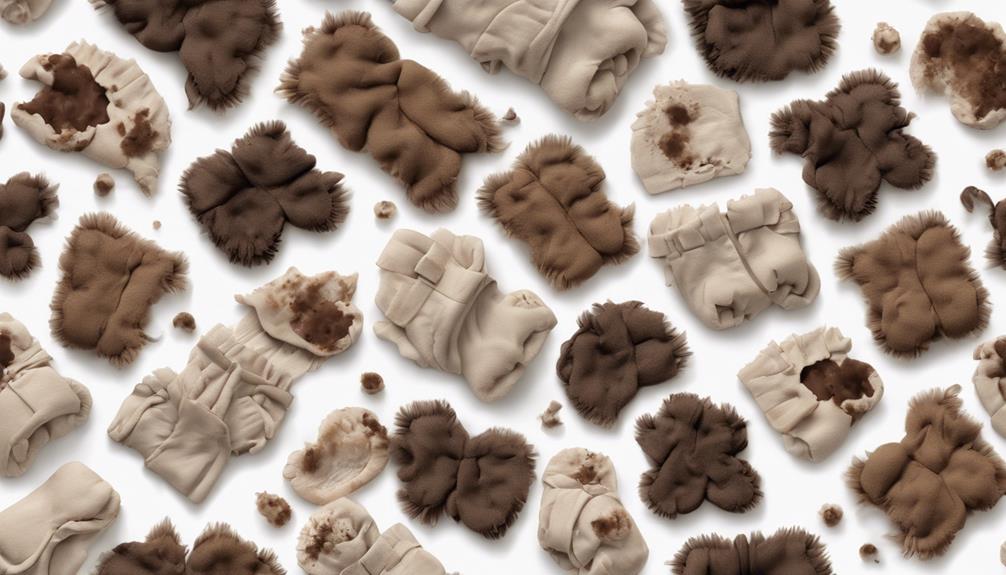Let's explore the perplexing puzzle of a newborn's brown poop. As parents, we often find ourselves scrutinizing every aspect of our little one's output, seeking clues to their well-being.
But what exactly constitutes normal when it comes to those dirty diapers? The shades of brown can hint at a baby's health, but what about texture, frequency, and other factors?
Join us as we unravel the mysteries of newborn poop and uncover the secrets it holds about our precious bundles of joy.
Key Takeaways
- Brown poop in newborns signifies healthy digestion and nutrient absorption.
- Variation in shades is normal due to bilirubin breakdown and bile presence.
- Breastfed babies have soft, yellow poop; formula-fed babies have brown stools.
- Monitoring frequency and consistency helps detect potential digestive issues early.
Shades of Brown Poop in Newborns
In newborns, the shades of brown poop can serve as a visual indicator of their digestive health and nutrient absorption. The variation in shades, ranging from light tan to dark brown, is closely linked to the breakdown of bilirubin in the liver and the presence of bile in the digestive system. A healthy diet rich in nutrients from breast milk or formula contributes to the normal appearance of brown poop in newborns, reflecting effective digestion and absorption processes.
It is essential to monitor changes in the shades of brown poop, as they may signify alterations in the baby's diet or minor fluctuations in their digestive system. By observing the consistency and frequency of brown poop, caregivers can gain valuable insights into the newborn's overall health and well-being. These subtle variations in shades provide essential clues about the baby's digestive processes and highlight the importance of closely monitoring their poop for any deviations from the norm.
Texture of Normal Newborn Poop
What factors influence the texture of normal newborn poop? The texture of newborn poop can vary based on several factors, giving insights into the baby's digestive health and hydration status. Here are some key points to take into account:
- Normal newborn poop texture is soft and mushy, often resembling mustard or seed-like consistency.
- Breastfed babies tend to have looser and more liquid poop compared to formula-fed babies.
- The texture of newborn poop may change during the shift from meconium, the baby's first stool, to regular stool.
- Healthy newborn poop can range from runny to pasty, depending on the baby's diet and digestion process.
- Monitoring the texture of newborn poop is essential as it can indicate whether the baby is adequately hydrated and their digestive system is functioning properly.
Understanding these variations in texture can help caregivers make sure the baby's well-being and address any concerns promptly.
Frequency of Newborn's Bowel Movements
The frequency of a newborn's bowel movements serves as an essential indicator of their digestive health and overall well-being. Newborns typically have several bowel movements a day, with breastfed babies pooping more frequently than formula-fed infants. By the age of 6 weeks, the number of bowel movements may decrease, and some breastfed babies can go several days without pooping. Formula-fed newborns usually have at least one bowel movement daily, but individual variations are common. Monitoring the frequency and consistency of a newborn's bowel movements is vital in evaluating their digestive health.
| Aspect | Breastfed Newborns | Formula-fed Newborns |
|---|---|---|
| Frequency | More frequent | At least once a day |
| Changes by 6 weeks | May decrease | Individual variations |
| Consistency | Soft, seedy | Firmer, pasty |
| Well-being | Indicates good digestion | May need monitoring |
| Importance | Key indicator of health | Should be consistent |
Factors to Consider in Newborn Poop

Considering various factors such as feeding method, diet, and digestive system maturity is essential when evaluating a newborn's poop color and consistency. When evaluating a baby's stool, it's important to understand the influence of these factors:
- Feeding Method: Breastfed newborns typically have mustard-yellow or greenish-brown poop due to the composition of breast milk, while formula-fed babies may have brown or green-tan poop with a firmer consistency.
- Diet: The type of milk or formula consumed by the baby can directly impact the color and texture of their stool.
- Digestive System: A newborn's digestive system is still developing, so changes in poop color and consistency can be expected as it matures.
- Hydration: Proper hydration is important for healthy digestion and can affect the appearance of a baby's stool.
- Medication: Certain medications or supplements taken by the mother or baby can also alter the color of the baby's poop.
Understanding these factors helps caregivers interpret the nuances of a newborn's poop and identify any potential issues early on.
Recognizing Normal Newborn Poop
When evaluating a newborn's poop, it is important to observe the color, texture, and frequency to recognize signs of normal bowel movements. Healthy newborn poop typically shifts from black meconium to brown, green, or yellow colors within the first few days of life. For breastfed infants, the poop is usually soft, seedy, and yellow, while formula-fed babies tend to have brown stools. The frequency of newborn poop can vary, with breastfed babies often having more frequent bowel movements compared to formula-fed infants. It is critical to regularly monitor the color, texture, and frequency of your newborn's poop to identify any potential health issues early on. Any changes in the consistency or color of the poop should be promptly discussed with a healthcare provider to safeguard the baby's well-being.
| Aspect | Breastfed Babies | Formula-Fed Babies |
|---|---|---|
| Color | Yellow | Brown |
| Texture | Soft, seedy | Varies |
| Frequency | More frequent | Less frequent |
Frequently Asked Questions
Is Brown Poop Normal for Newborn?
Brown poop is normal for newborns. It signifies healthy digestion and feeding. Consistent brown poop is a positive sign of normal bowel movements. Monitoring its color and consistency guarantees the baby's wellness.
What Does Unhealthy Newborn Poop Look Like?
Unhealthy newborn poop can vary in color, consistency, odor, and frequency, showcasing potential health issues. Red, black, or white colors, watery or hard textures, unusual smells, mucus, or visible blood, and changes in bowel movements can signal digestive problems.
When Should I Be Concerned About My Newborn's Poop?
If our newborn's poop shows unusual colors, persistently contains mucus, or varies in consistency drastically, it's time to consult a healthcare provider. Any concerns about the frequency, smell, or texture of their poop warrant prompt medical attention.
What Is Worrisome Poop for Newborns?
Concerning newborn poop includes persistent black stool after the first week, unusual colors like red or white, and mucus. Any changes should be evaluated by a healthcare provider promptly to safeguard the baby's health.
Conclusion
In summary, understanding a newborn's brown poop is vital for monitoring their health and well-being. By recognizing the shades of brown, texture, frequency, and other factors in their poop, parents can detect any potential issues early on.
Remember, a baby's poop can provide valuable insights into their digestive system, so paying attention to these details is essential for ensuring their best health and development. Stay vigilant and seek medical advice if you notice any abnormalities.










